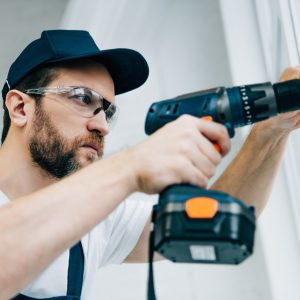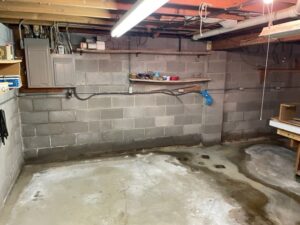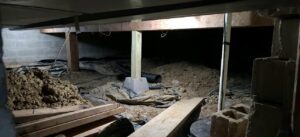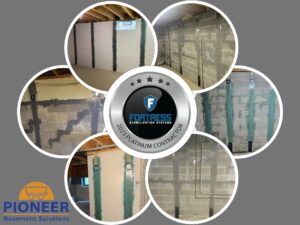Basement Wall Repair
How do you know what the best basement wall repair is for your basement? There are several types of foundation repair methods available and each is designed to solve a specific issue. There are basement walls that are tipping in at the top and basement walls that are bowing in along a horizontal crack. Then there are foundations that are crumbling or have severe mortar rot. Some basements have settling issues which result in vertical cracks in basement walls or stair step cracking in the walls. And then there are basement walls that have a sheer break in them resulting in the wall sliding inwards along the break.
Interviewing foundation repair companies can add to the confusion because you may get differing proposals. The reason this may happen is due to the numerous foundation repair companies that hire and train salespeople to sell a specific product or method. Foundation repair contractors that are part of a national chain or franchise will only propose (quote) the solutions they have contractual agreements to sell. These contractors often present many solutions and go through a sales process to bring you to a conclusion that the one product they install is the one you need. So look for locally owned and operated foundation repair contractors who can not only offer different solutions but also install any of them when you need basement wall repair.
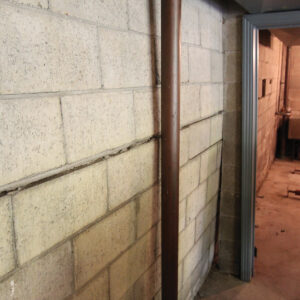
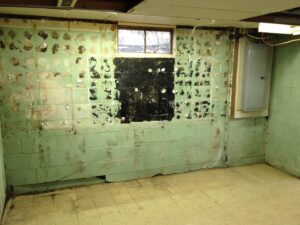
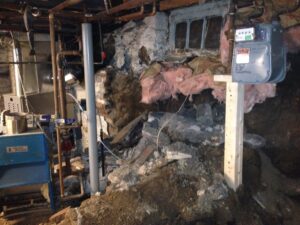
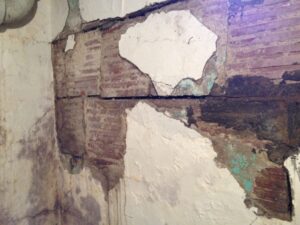
As a rule of thumb, basement walls that are bowing in can be reinforced to prevent further movement. Note: up to 2″ of inward bowing or less is required, anything beyond that and your wall is no longer structurally sound and should be replaced. Some basement walls can be straightened, but only if there are open cracks that have never been filled in. Continuing the thought of straightening bowing basement walls, to do it properly you must excavate the soil away on the outside first to relieve the pressure allowing the wall to go back to its best position. Walls that have the cracks caulked or filled in will not straighten up. The filler binds the joint and prevents the crack that opened from closing back up which is what straightening the wall is actually doing.
Back to reinforcing bowing basement walls. Steel I beams as a basement wall repair method can be used. Steel I beams are to be buried below the floor and cemented in at the bottom and properly attached to the wood structure above. In this scenario the floor below and the wood structure above are actually holding the I beam in place. Steel beams are straight so they only touch the wall where it is bowed out. The gaps at top and bottom between the wall and beam should be filled in to prevent the wall from shifting behind the beam. Downsides are steel beams are unsightly, can rust, and still can flex. Also if the soil conditions outside push on the wall it can cause the beam to put pressure on the wood structure causing it to shift or twist.
The latest basement wall repair method for bowing basement walls is carbon fiber mesh “straps” which are embedded into the face of your foundation walls. And the latest of those are made by Fortress Stabilization who has developed a system made of both carbon fiber and Kevlar meshed together giving them the ultimate in tensile and shear strength. These straps are smooth to the wall and paintable making them barely noticeable. Carbon fiber / Kevlar mesh straps are embedded into the face of the wall with a two part epoxy becoming part of the structure. How this method works is that the straps are inflexible / do not stretch so they create tension on the wall preventing movement. Soil pressure outside is diffused and the wall is permanently stabilized.
If your basement wall has a sheer, meaning a row of block has slid inward off of the row below it a half inch or more, it needs to be replaced. Some basement walls with a sheer less than a half inch can be stabilized with steel beams to prevent further movement but for the most part this is an indication of severe drainage problems resulting in water build up at the bottom of the basement wall outside. This build up results in the foundation and or mortar rotting out, becoming weak, and resulting in the shift. Often times this results in dirt and/or mud coming into the basement through the broken areas.
Tipping basement walls are a result of them not being well attached to the structure above during construction. This is a wall that is straight from bottom to top but leaning inward at the top. This is different from bowing as you will not see a horizontal crack that is opened up. Fixing tipping basement walls involves first removing the soil outside to relieve pressure. Then a system of steel beams and screws / jacks are used to slowly push the wall back into its best possible position. The steel beams can be left in place to hold the wall from further movement or other methods can be used to secure the structure above to the foundation to prevent movement.
Obviously if you have a collapsed basement wall, it would need full replacement, enough said.
Crumbling and rotting foundations occur due to the original waterproofing seal failing, allowing water into the basement wall. In many cases, if this is caught early enough the wall can be excavated, repaired, reinforced, waterproofed, and ultimately saved. The cost of going through all of that may be getting very close to replacing the basement wall and some walls with rot and decay should simply be replaced.
Settling foundations are those that are sinking into poor soil conditions. Signs of a sinking foundation include stair-step cracks, vertical cracks, and issues in the living space above such as cracked walls, ceilings, and doors that do not close properly. To stop a settling foundation it requires installing reinforcement below the foundation installed into a solid substrate. This method is often called underpinning or piering. We favor the Stabil-Loc Foundation Piering System. Its patent-pending load-bearing design installs directly under the wall being lifted. Its unique interlocking high strength steel construction can support up to 300,000 lbs. There are no bolts, no brackets, no breaking the footing, and no off-set loads. This pier carries an Engineer Certified safety factor of more than 10 to 1.
Contact Pioneer today to schedule a no-pressure visit to evaluate your foundation and the basement wall repair methods available.

